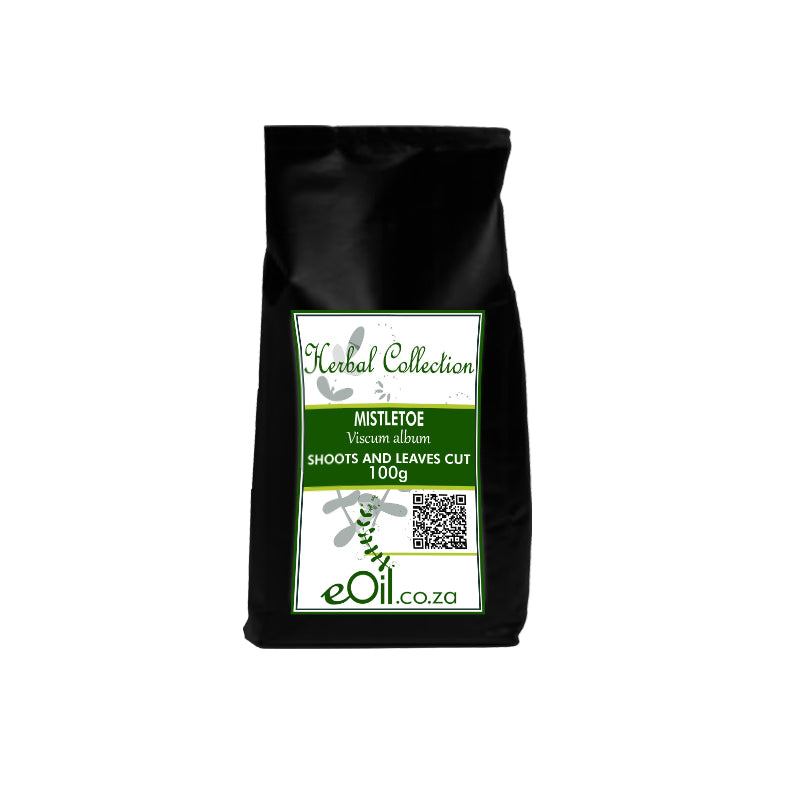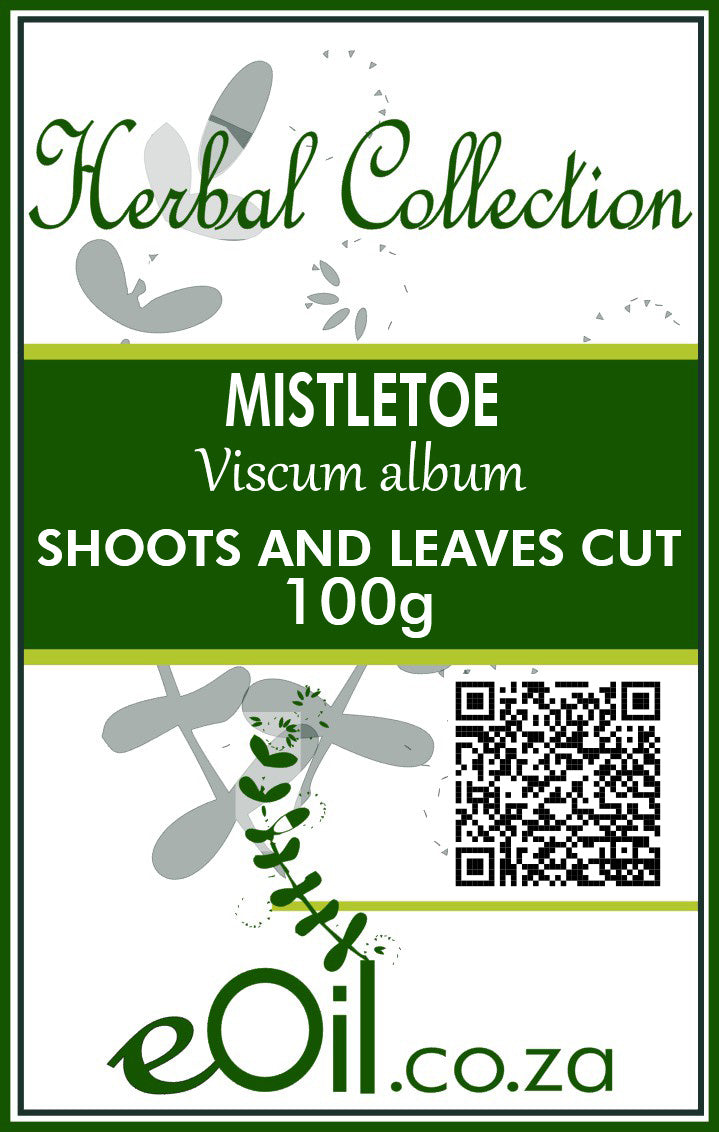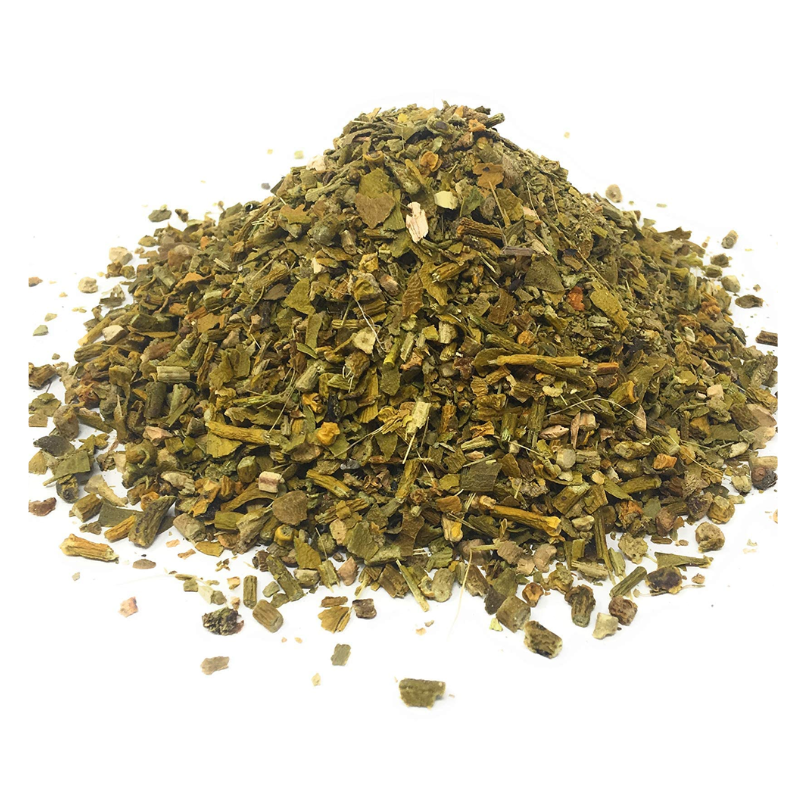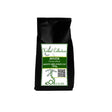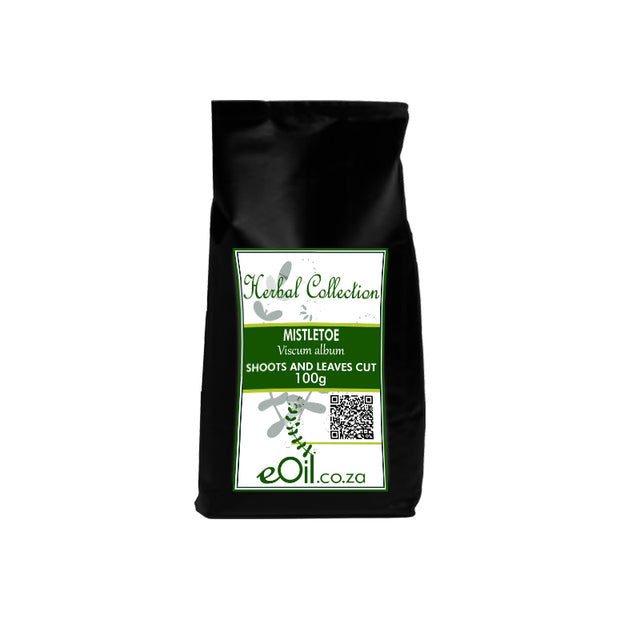Mistletoe Cut Dried (Viscum album) - Herbal Collection
Mistletoe Cut Dried (Viscum album) - Herbal Collection - 100 GR is backordered and will ship as soon as it is back in stock.
Description
Description
Mistletoe Cut Dried (Viscum album) is a traditional botanical used in herbal teas, blends, and wellness rituals.
Naturally dried and rich in nutrients, these cut leaves support daily vitality and are valued for promoting relaxation and circulatory balance.
Pure, additive-free, and suitable for infusions or natural herbal preparations
TRADITIONALLY USED FOR
May help with
- Headache
- High blood pressure - hypertension
- epilepsy
- asthma
- menopausal symptoms
- arthritis
INFORMATION
Mistletoe tea can be prepared in several ways, with both hot infusion and cold maceration being common, just like normal tea:
Hot Infusion:
Place 1 teaspoon (about 5 grams) of dried mistletoe leaves in a cup (about 250 ml) of hot (not boiling) water.
Steep for 5–10 minutes, then strain and drink. You may sweeten the tea with honey or lemon if desired.
Cold Maceration:
Soak 2–4 teaspoons (5–12 grams) of chopped mistletoe in 2 cups (500 ml) of cold water overnight.
Strain and drink in the morning; another batch can be prepared for consumption at bedtime.
This method preserves more of certain active compounds, such as mistletoe lectins, which may be degraded by heat.
Dosage Recommendations
Typical dosages range from 1 cup of tea 3–4 times a day for adults, using either the infusion or maceration method.
For hypertension, a total daily dose of up to 10 grams of dried herb may be used, divided into servings.
Always consult a healthcare professional before use, especially if you have underlying health conditions or take medications
Reported Purposes and Benefits of Mistletoe Tea
Traditional and Modern Uses
Cardiovascular Health:
Traditionally used to relieve symptoms of mild cardiovascular disorders such as dizziness and mild hypertension.
Nervous System Support:
Acts as a nervine, helping to reduce anxiety, stress, and insomnia by lowering cortisol and supporting the nervous system.
Diabetes Support:
Some evidence suggests mistletoe may stimulate insulin release and help manage diabetes, though more research is needed.
Immune and Cancer Support:
Mistletoe extracts (not teas) are used as complementary therapy in cancer treatment, with effects on quality of life and possible antitumor activity, but these are usually administered by injection under medical supervision.
General Immune Support:
Mistletoe tea is sometimes used to support immunity, though evidence for this use is less robust.
Safety and Precautions
Toxicity:
Mistletoe contains toxic compounds; avoid use during pregnancy and lactation.
Side Effects:
Possible mild side effects include digestive upset or allergic reactions. Injectable forms may cause more serious reactions and should only be used under medical supervision.
Drug Interactions:
May interact with blood pressure medications and other drugs; consult a healthcare provider before use.
Source : http://www.wikiphyto.org/wiki/mistletoe
Reference on http://www.wikiphyto.org
Translation in English by Google Translate (go to the page of the source linked | on Chrome cellphones go on the 3 dots on the top right and select translate in your preferred language | on laptop right click your mouse and select option translate when hoovering on the page
plant name
Mistletoe, Glu , Holy Cross Wood , mistletoe (English)
International Latin denomination
Viscum album L. and subspecies
botanical family
Viscaceae (formerly Loranthaceae ) according to the Cronquist classification.
- In the new APGIII classification, mistletoe belongs to the Santalaceae family.
Description and habitat
- Dioecious shrub called hemi-parasitic (because it contains a little chlorophyll), forming large clumps on parasitized trees, very visible in winter because the plant remains always green
- Articulated stems, simple green leaves, not petiolate, oval and spatulate, persistent, leathery, arranged in opposite pairs at the end of the branches, blade traversed by five parallel veins, branching is dichotomous by abortion of the terminal bud, leading to a form characteristic ball, yellowish flowers in spring, the fruits are small white berries which are disseminated by birds, either by peeling them on the branch to which they remain stuck by the glue (or viscine), or in their droppings after absorption and pass through their intestines. The berries, or "mistletoe balls", less than a centimeter in diameter, persist on the twigs all winter
- Native to all of Europe and Asia
- There are different subspecies in Europe: Viscum abietis (firs), Viscum austriacum (pines, larches, spruces), Viscum album (deciduous trees), meridianum, cretinum
- According to the botanist De Candolle, "the mistletoe is an exception in all the rules of plant biology"
History and tradition
- Very used in the past by the druids who sought first and foremost the very rare oak mistletoe. The Druids considered the tuft of mistletoe that appeared on a sessile oak as a sacred sign from heaven. According to Pliny, they practiced the cutting of it on the sixth day of the moon by means of a golden sickle, collecting the precious branches in a white tunic
- The careful analogical observation made by some doctors has provided elements that have completed the pharmacological knowledge of this plant.
- It is indeed a so-called hemi-parasitic plant but which remains green and contains chorophyll. Its sheet is identical on both sides, it shows neither heliotropism (does not turn towards the sun) nor geotropism (seems not to be subject to terrestrial attraction). It maintains itself as if in weightlessness, between two worlds
- Remarkably, the "ball" of mistletoe delimits a spherical space (it has no roots or centrifugal shoots), and inside the ball a caloric space where it is a little warmer (this small gradient of temperature can be measured by thermography). Leaf development is bipolar (symmetrical development), the plant has no bark (i.e. it does not include a mineral element)
- On the contrary, there is an animal element involved because the germination of the berries depends essentially on the birds (most often by passing through their intestines or by crushing the mistletoe balls they eat on the branch) and pollination is ensured by insects.
- Its maturity is winter, it flowers in winter. Plants that work "in reverse" of others often have remarkable features. The mistletoe develops against the current of the usual plant laws, it is in a way a "plant in rebellion", an "extra-terrestrial"
- It appropriates the structuring forces of the host to develop its own vascular network (it will have an action on tumor neo-vascularization), it expresses a concentric spherical geometric arrangement, controlled development, without aggressiveness for the host tree , at least initially
- It does not experience senescence, it retains a juvenile and even embryonic character which contrasts with its pharmacological richness.
- We suspected a genetic predisposition to accept mistletoe from the host (some trees die if you cut all the balls of mistletoe). [1]
- The careful analogical observation made by some doctors has provided elements that have completed the pharmacological knowledge of this plant.
Parts used
- leaf in herbal medicine
- Fruiting aerial parts (stem, leaf and fruit) in homeopathy
- Fermentation of summer and winter mistletoe, in a mixture, for the production of fermented Viscum album or Iscador®
Dosage forms available
- Mother tincture :
- Viscum album Aerial part with fruits
- Viscum abietis Aerial part with fruits
- Viscum crataegi Aerial part with fruits
- Viscum mali Aerial part with fruits
- Viscum pini Aerial part with fruits
- Viscum quercus Aerial part with fruits
- Glycerine macerate of Viscum album Young shoot
- Specific injectable preparations of fermented mistletoe Viscum album fermented (in France) or Iscador (in Switzerland and Germany)
Usual dosages
Composition
Main components of the plant
- Lectins (glycoproteins): mistletoe lectin I, II and III, made up of two polypeptide chains A and B
- Lectin levels vary according to the host plant species associated with mistletoe, respectively for pine (P), apple (M) and oak (Q): very low, average, high.
- Viscotoxins : stable basic polypeptides of about 46 amino acids (= thionines )
- Flavonoids derived from isorhamnetol and quercetol , rhamnazol , etc.
- Phenylpropanes and lignans : syringenin-4'-glucoside and syringaresinol-4'-4''-diglucoside
- Other phenolic compounds
- Polysaccharides : galacturonan and arabinogalactan
- Biogenic amines: tyramine, choline, histamine, etc.
- Cyclitols : viscumitol [2]
- Amino-alkaloid
- Diarylheptanoids and D gamma-hydroxybutyric acid
- Triterpene derived from oleanolic acid
- The host species influences the amount of viscotoxins but not their composition [3]
Main components of buds or young shoots
Main components of essential oil
Properties
Plant properties
- Anticancer properties:
- Proteins are thymus stimulants
- It increases the number of macrophages which promotes the cleaning of cancer cells
- The antitumor activity is due to its lectins (cytotoxic at doses below ng/ml), without being the only active molecules [4] , which cause cell death by apoptosis
- Viscotoxin and mistletoe lectin are cytotoxic to different cell lines [5] , viscotoxins cause necrotic death
- Synergy between the A and B chains of lectins (inhibition of protein synthesis by the A chain, which accelerates cell destruction induced by the B chains) [6]
- Thionins ( viscotoxins ) are involved in NK cell-induced membrane destruction [7] , [8]
- Immunostimulating activity at lower, non-toxic doses (increase of cytokines by monocytes, especially TNF alpha [9] , increase in immunocompetent cells, natural killer cells, & cytotoxic T-cells) [10] , [11] , activity differs according to dosage modifications [12] , activity on interleukin-12 [13] , pro-inflammatory activity [14]
- Mistletoe extracts protect DNA from cyclophosphamide-treated lymphocytes, although they are cytotoxic to tumor cells and lymphocytes [15]
- Action on angiogenesis [16] and apoptosis [17] , in addition to activity on immuno-modulation [18] , [19]
- Increased beta-endorphin secretion (neuro-endocrine system, which improves quality of life) [20]
- Administration of mistletoe produces hypereosinophilia [21] and an increase in CD4 count (vs. placebo), production of IL-6 and CRP is not affected [22]
- Cytotoxicity differs depending on the host trees and their lectin content [23] , [24]
- Fermented mistletoe extract marketed under the name ISCADOR in Germany reduces cell proliferation and decreases migratory and invasive capacity. Fermented mistletoe extract is a multimodal antitumor agent, which acts through several mechanisms. Mistletoe lectins have been identified as the main components responsible for the activity and exhibit cytotoxic effects as well as immunomodulatory activity. Even if clinical trials are favorable, the difficulty in evaluating the clinical results is due to the fact that the effects on the immune system are not reproduced identically. Gamma-ray irradiation (at a dose of 5KGy) of mistletoe lectins reduces toxicity and maintains immunological response
- Iscador induces very rapid lysis of rat hepatoma cells cultured in vitro , after disorganization of their cytoplasm, then of their nucleus
- The use of Iscador is correlated with a reduction in cancer mortality [25] , improved quality of life and longevity in breast cancer [26] , [27] , numerous literature reviews show a favorable effect on quality of life and survival, with improved tolerance to conventional treatments [28] , [29] , [30] , [31] , [32] although some call for additional studies [33]
- The combination of viscum with chemotherapy does not diminish its effects, on the contrary high doses show an additive effect [34]
- Good tolerance [35]
- Moderate but real hypotensive activity in mother tincture (10 drops three times a day), coupled with a hypotriglyceridemic effect [36] , it has a spasmolytic activity of the intestinal and vascular smooth muscles [37]
- Other properties: antioxidant, anti-inflammatory, hepatoprotective, sedative ( flavonoids , triterpenes , phytosterols , oligosaccharides, polysaccharides ) [38]
Bud properties
Properties of essential oil
Directions
Indications of the whole plant (phytotherapy)
- Cancerous diseases, with a precise protocol and very specific galenic preparations = “ Fermented Viscum album ” in France or “ Iscador ®” in Germany
- Bladder instillations in bladder cancer [39] , [40] , [41]
- Melanomas [42] , [43]
- Pancreatic cancers [44]
- Reduction in the frequency of respiratory infections due to the effects of radioactivity in children exposed to the Chernobyl nuclear accident [45]
Indications of the bud (gemmotherapy)
Specific indications of essential oil (aromatherapy)
Known or suspected mode of action
- The A and B polypeptide chains of lectins separate when they enter the cell, and have distinct activities:
- A inhibits ribosome activity, leading to cell death
- B binds to sugars and induces apoptosis
- The name lectin comes from the Latin “legere” = to read, choose, “select” because these proteins bind reversibly to osidic receptors on cell membranes, some differentiate normal cells from tumor cells, they are denatured by cooking [46 ]
Usual formulations
- Choice of Viscum depending on the location of the tumor [47]
- Men Women
- a) Digestive system
- Tongue, oral cavity, esophagus
- Mali _
- Stomach, liver, gallbladder, spleen
- Querci + Cuprum Mali + Cuprum
- Pancreas
- Querci + Cuprum Mali + Cuprum
- Small intestine and large intestine, rectum
- Querci + Mercurius Mali + Mercurius
- b) Urogenital system
- Kidneys
- Querci + Cuprum Mali + Cuprum
- Bladder
- Querci + Arg. Mali + Arg.
- prostate, testicle, penis
- Querci + Arg.
- Uterus, ovary, vulva, vagina
- Mali + Arg.
- c) Breast
- before menopause Mali + Arg.
- possibly Mali + Mercurius
- after menopause Pini + Mercurius
- d) Respiratory system
- nose, throat
- pini pini
- Thyroid gland
- Mali _
- Larynx
- Mali _
- Bronchi
- Pini + Mercurius Querci + Mercurius
- Pleura
- Pini or Ulmi + Mercurius Pini or Ulmi + Mercurius
- e) Carcinomas of the skin
- Pini + Mercurius Pini + Mercurius
- f) Ends
- Mali _
- a) Digestive system
- Men Women
Regulations
- French Pharmacopoeia list B (sheet)
- Fruiting aerial parts (stem, leaf and fruit), fresh, of mistletoe ( Mistletoe ), Viscum album L., Loranthaceae, harvested from the Malus domestica Borkh apple tree . are the subject of a monograph "Apple tree mistletoe for homeopathic preparations" in the French Pharmacopoeia 2010.
- The dye must contain a minimum dry residue of 2.5% and at least 0.006% m/m of lignans expressed as syringic acid (measured by HPLC). A TLC of flavonoids is required.
Possible side effects and precautions for use
- Pharmacokinetic interactions:
- Inhibition of CYP 3A4
- Toxicity especially by injection: the equivalent of a branch of mistletoe prepared in injections would kill 8000 mice
- Low toxicity with leaves, preparations in dilutions, more important for poisoning with berries
- But does not cause immunosuppression [48]
- Contraindication of fermented Viscum in brain tumors (due to the centrifugal and pro-inflammatory action of Viscum )
- Theoretical contraindication in leukemias and lymphomas
- During treatment with Viscum , it is possible that local or general reactions appear, such as an inflammatory area at the injection site, especially for the highest concentration, sometimes even a feeling of general warmth, or even a bout of fever. and in any case a variation (gradient) of temperature between morning and afternoon
- These reactions are desirable, testifying to a revival of the immune functions; if necessary, space out the shots [49]
Bibliographic references
- Go↑ Jean-Michel Morel. Practical treatise on phytotherapy. Ed. Grancher, 2008.
- Go↑ Richter A. Viscumitol, a dimethyl-ether of muco-inositol from Viscum album. Phytochemistry. 1992, vol. 31, no.11, pp. 3925-3927
- Go↑ Schaller G, Urech K, Grazi G, Giannattasio M. Viscotoxin composition of the three European subspecies of Viscum album. PlantaMed. 1998 Oct;64(7):677-8. PMID 17253311
- Go↑ Eggenschwiler J, von Balthazar L, Stritt B, Pruntsch D, Ramos M, Urech K, Rist L, Simoes-Wüst, Viviani A. Mistletoe lectin is not the only cytotoxic component in fermented preparations of Viscum album from white fir (Abies pectinata ). BMC Complementary and Alternative Medicine 2007; 7: 14. PMID 17493268 Full text: [1]
- Go↑ Urech, K., Schaller, G., Ziska, P. and Giannattasio, M. (1995), Comparative study on the cytotoxic effect of viscotoxin and mistletoe lectin on tumor cells in culture. Phytother. Res., 9: 49-55. doi:10.1002/ptr.2650090112
- Go↑ Büssing A, Suzart K, Schweizer K. Differences in the apoptosis-inducing properties of Viscum album L. extracts. Anticancer Drugs. 1997 Apr;8 Suppl 1:S9-14. PMID 9179360
- Go↑ Tabiasco J, Pont F, Fournie JJ, Vercellone A. Mistletoe viscotoxins increase natural killer cell-mediated cytotoxicity. Eur J Biochem. 2002 May;269(10):2591-600. PMID 12027898
- Go↑ Hajto T, Hostanska K, Weber K, Zinke H, Fischer J, Mengs U, Lentzen H, Saller R. Effect of a recombinant lectin, Viscum album agglutinin on the secretion of interleukin-12 in cultured human peripheral blood mononuclear cells and on NK-cell-mediated cytotoxicity of rat splenocytes in vitro and in vivo. Nat Immun. 1998;16(1):34-46. PMID 9789123
- Go↑ Pae HO, Seo WG, Oh GS, Shin MK, Lee HS, Lee HS, Kim SB, Chung HT. Potentiation of tumor necrosis factor-alpha-induced apoptosis by mistletoe lectin. Immunopharmacol Immunotoxicol. 2000 Nov;22(4):697-709. PMID 11105782
- Go↑ Braedel-Ruoff S. Immunomodulatory effects of Viscum album extracts on natural killer cells: review of clinical trials. Forsch Complementmed. 2010 Apr;17(2):63-73. PMID 20484913
- Go↑ Büssing A. Immune modulation using mistletoe (Viscum album L.) extracts Iscador. Arzneimittelforschung. 2006 Jun;56(6A):508-15. PMID 16927532
- Go↑ Büssing A, Stumpf C, Tröger W, Schietzel M. Course of mitogen-stimulated T lymphocytes in cancer patients treated with Viscum album extracts. Anticancer Res. 2007 Jul-Aug;27(4C):2903-10. PMID 17695469
- Go↑ Duong Van Huyen JP, Delignat S, Bayry J, Kazatchkine MD, Bruneval P, Nicoletti A, Kaveri SV. Interleukin-12 is associated with the in vivo anti-tumor effect of mistletoe extracts in b16 mouse melanoma. Cancer Lett. 2006 Nov 8;243(1):32-7. INSERM U430, Cordeliers Institute, IFR 58, Paris. PMID 16412563
- Go↑ Hostanska K, Hajto T, Fischer J, Mengs U, Weber K, Lentzen H, Saller R. Selective modulation of phosphatidylserine exposure on subpopulations of human peripheral blood lymphocytes by a plant lectin, Viscum album agglutinin (VAA)-I and its recombinant form (rVAA) in vitro. Cancer Detect Prev. 1999;23(6):511-23. PMID 10571662
- Go↑ Burkhart J, Wälchli C, Heusser P, Weissenstein U, Baumgartner S, Andres AC. In vitro investigation into the potential of a mistletoe extract to alleviate adverse effects of cyclophosphamide. Altern Ther Health Med. 2010 May-Jun;16(3):40-8. PMID 20486623
- Go↑ Elluru SR, Duong Van Huyen JP, Delignat S, Prost F, Heudes D, Kazatchkine MD, Friboulet A, Kaveri SV. Antiangiogenic properties of viscum album extracts are associated with endothelial cytotoxicity. Anticancer Res. 2009 Aug;29(8):2945-50. PMID 19661299 full text
- Go↑ Harmsma M, Gromme M, Ummelen M, Dignef W, Tusenius KJ, Ramaekers FC. Differential effects of Viscum album extract Iscador(R)Qu on cell cycle progression and apoptosis in cancer cells.. Int J Oncol. 2004 Dec;25(6):1521-9. [2]
- Go↑ Duong Van Huyen JP, Bayry J, Delignat S, Gaston AT, Michel O, Bruneval P, Kazatchkine MD, Nicoletti A, Kaveri SV. Induction of apoptosis of endothelial cells by Viscum album: A role for anti-tumor properties of mistletoe lectins. Molecular Medicine. 2002 Oct;8(10):600-6. PMID 12477970 Full text: [3]
- Go↑ Elluru S, Duong Van Huyen JP, Delignat S, Prost F, Bayry J, Kazatchkine MD, Kaveri SV. Molecular mechanisms underlying the immunomodulatory effects of mistletoe (Viscum album L.) extracts Iscador. Arzneimittelforschung. 2006 Jun;56(6A):461-6. PMID 16927527
- Go↑ Grossarth-Maticek R, Kiene H, Baumgartner SM, Ziegler R. Use of Iscador®, an extract of european mistletoe (Viscum album) in cancer treatment: prospective nonrandomized and randomized matched-pair studies nested within a cohort study. Alternative therapies in health and medicine, May-June 2001; vol.7, n°3, pp. 57-78. Full Text
- Go↑ Huber R, Barth H, Schmitt-Graff A, Klein R. Hypereosinophilia induced by high-dose intratumoral and peritumoral mistletoe application to a patient with pancreatic carcinoma. J Altern Complement Med. 2000 Aug;6(4):305-10. PMID 10976976
- Go↑ Huber R, Ludtke H, Wieber J, Beckmann C. Safety and effects of two mistletoe preparations on production of Interleukin-6 and other immune parameters - a placebo controlled clinical trial in healthy subjects. BMC Complementary and Alternative Medicine 2011, 11:116 (24 November 2011)
- Go↑ Duong Van Huyen JP, Delignat S, Kazatchkine MD, Kaveri SV. Comparative study of the sensitivity of lymphoblastoid and transformed monocytic cell lines to the cytotoxic effects of Viscum album extracts of different origin. Chemotherapy. 2003 Dec;49(6):298-302. PMID 14671430
- Go↑ Eggenschwiler J, Patrignani A, Wagner U, Rehrauer H, Schlapbach R, Rist L, Ramos MH, Viviani A. Gene expression profiles of different breast cancer cells compared with their responsiveness to fermented mistletoe (Viscum album L.) extracts Iscador from oak (Quercus), pine (Pinus), white fir (Abies) and apple tree (Malus) in vitro. Arzneimittelforschung. 2006 Jun;56(6A):483-96. PMID 16927530
- Go↑ Ostermann T, Raak C, Büssing A. Survival of cancer patients treated with mistletoe extract (Iscador): a systematic literature review. BMC Cancer 2009, 9:451 PMID 20021637 full text: [4]
- Go↑ Bock PR, Friedel WE, Hanisch J, Karasmann M, Schneider B. Efficacy and Safety of Long-term Complementary Treatment with Standardized European Mistletoe Extract (Viscum album L.) in Addition to the Conventional Adjuvant Oncological Therapy in Patients with Primary Non- metastatic Breast Cancer. Results of a multicentre, comparative, epidemiological cohort study in Germany and Switzerland. Arzneim.-Forsch./Drug Res. 2004 ; 54, No. 8, 456-466. Full text: [5]
- Go↑ Schumacher K, Schneider B, Reich G, Stiefel T, Stoll G, Bock PR, Hanisch J, Beuth J. Influence of postoperative complementary treatment with lectin-standardized mistletoe extract on breast cancer patients. A controlled epidemiological multicentric retrospective cohort study. Anticancer Res. 2003 Nov-Dec;23(6D):5081-7. PMID 14981970
- Go↑ Horneber MA, Bueschel G, Huber R, Linde K, Rostock M. Mistletoe therapy in oncology. Cochrane Database System Rev. 2008 Apr 16;(2):CD003297. PMID 18425885
- Go↑ Kienle GS, Kiene H. Complementary cancer therapy: a systematic review of prospective clinical trials on anthroposophic mistletoe extracts. Eur J Med Res. 2007 Mar 26;12(3):103-19. PMID 17507307
- Go↑ Kienle GS, Kiene H. Review article: Influence of Viscum album L (European mistletoe) extracts on quality of life in cancer patients: a systematic review of controlled clinical studies. Integr Cancer Ther. 2010 Jun;9(2):142-57. PMID 20483874
- Go↑ Kienle GS, Berrino F, Büssing A, Portalupi E, Rosenzweig S, Kiene H. Mistletoe in cancer - a systematic review on controlled clinical trials. Eur J Med Res. 2003 Mar 27;8(3):109-19. PMID 12730032
- Go↑ Piao BK, Wang YX, Xie GR, Mansmann U, Matthes H, Beuth J, Lin HS. Impact of complementary mistletoe extract treatment on quality of life in breast, ovarian and non-small cell lung cancer patients. A prospective randomized controlled clinical trial. Anticancer Res. 2004 Jan-Feb;24(1):303-9. PMID 15015612
- Go↑ Ernst E, Schmidt K, Steuer-Vogt MK. Mistletoe for cancer? A systematic review of randomized clinical trials. Int J Cancer. 2003 Nov 1;107(2):262-7. PMID 12949804
- Go↑ Weissenstein U, Kunz M, Urech K, Baumgartner S. Interaction of standardized mistletoe (Viscum album) extracts with chemotherapeutic drugs regarding cytostatic and cytotoxic effects in vitro. BMC Complementary and Alternative Medicine 2014, 14:6 (8 January 2014) Full text abstract
- Go↑ Gunver S Kienle, Renate Grugel, Helmut Kiene Safety of higher dosages of Viscum album L. in animals and humans - systematic review of immune changes and safety parameters. BMC Complementary and Alternative Medicine 2011, 11:72 doi:10.1186/1472-6882-11-72
- Go↑ Poruthukaren KJ, Palatty PL, Baliga MS, Suresh S. Clinical evaluation of Viscum album mother tincture as an antihypertensive: a pilot study. J Evid Based Complementary Altern Med. 2014 Jan;19(1):31-5. doi: 10.1177/2156587213507726. PMID 24647376
- Go↑ Khan T, Ali S, Qayyum R, Hussain I, Wahid F, Shah A. Intestinal and vascular smooth muscle relaxant effect of Viscum album explains its medicinal use in hyperactive gut disorders and hypertension. BMC Complementary and Alternative Medicine 2016, 16:251 (27 July 2016) Abstract [6]
- Go↑ Nazaruk J, Orlikowski P. Phytochemical profile and therapeutic potential of Viscum album L. Nat Prod Res. 2016;30(4):373-85. doi: 10.1080/14786419.2015.1022776. Epub 2015 Mar 27. phenolic acids, phenylpropanoids and PMID 25813519
- Go↑ Hunziker-Basler N, Zuzak TJ, Eggenschwiler J, Rist L, Simões-Wüst AP, Viviani A. Prolonged cytotoxic effect of aqueous extracts from dried viscum album on bladder cancer cells. Pharmacy. 2007 Mar;62(3):237-8. PMID 17416204
- Go↑ Urech K, Buessing A, Thalmann G, Schaefermeyer H, Heusser P. Antiproliferative effects of mistletoe (Viscum album L.) extract in urinary bladder carcinoma cell lines. Anticancer Res. 2006 Jul-Aug;26(4B):3049-55. PMID 16886633
- Go↑ Mengs U, Schwarz T, Bulitta M, Weber K. Madaus AG. Antitumor effects of an intravesically applied aqueous mistletoe extract on urinary bladder carcinoma MB49 in mice. Anticancer Res. 2000 Sep-Oct;20(5B):3565-8. PMID 11131663
- Go↑ Augustin, M., Bock, P., Hanisch, J., Karasmann, M., & Schneider, B. (2011). Safety and Efficacy of the Long-term Adjuvant Treatment of Primary Intermediate- to High-Risk Malignant Melanoma (UICC/AJCC Stage II and III) with a Standardized Fermented European Mistletoe (Viscum album L.) Extract. Arzneimittelforschung, 55(01), 38–49. doi:10.1055/s-0031-1296823
- Go↑ Werthmann PG, Hintze A, Kienle GS. Complete remission and long-term survival of a patient with melanoma metastases treated with high-dose fever-inducing Viscum album extract: A case report. Medicine (Baltimore). 2017;96(46):e8731.
- Go↑ Tröger W, Galun D, Reif M, Schumann A, Stanković N, Milićević M. Viscum album [L.] extract therapy in patients with locally advanced or metastatic pancreatic cancer: a randomized clinical trial on overall survival. Eur J Cancer. 2013 Dec;49(18):3788-97. doi: 10.1016/j.ejca.2013.06.043. PMID 23890767
- Go↑ Chernyshov VP, Heusser P, Omelchenko LI, Chernyshova LI, Vodyanik MA, Vykhovanets EV, Galazyuk LV, Pochinok TV, Gaiday NV, Gumenyuk ME, Zelinsky GM, Schaefermeyer H, Schaefermeyer G. Immunomodulatory and clinical effects of Viscum album (Iscador M and Iscador P) in children with recurrent respiratory infections as a result of the Chernobyl nuclear accident. Am J Ther. 2000 May;7(3):195-203. PMID: 11317168
- Go↑ Bruneton J. Pharmacognosy, Phytochemistry, Medicinal Plants. Ed. Tec and Doc. 1997.
- Go↑ Weleda documentation
- Go↑ Kienle GS, Grugel R, Kiene H. Safety of higher dosages of Viscum album L. in animals and humans--systematic review of immune changes and safety parameters. BMC Complement Altern Med. 2011 Aug 28;11:72. doi: 10.1186/1472-6882-11-72. PMID 21871125
- Go↑ Büssing A, Tröger W, Stumpf C, Schietzel M. Local reactions to treatments with Viscum album L. extracts and their association with T-lymphocyte subsets and quality of life. Anticancer Res. 2008 May-Jun;28(3B):1893-7. PMID 18630477
- National Cancer Institute study and bibliography: http://www.cancer.gov/cancertopics/pdq/cam/mistletoe/HealthProfessional/page5
- Ziegler R. Mistletoe Preparation Iscador: Are there Methodological Concerns with Respect to Controlled Clinical Trials?Evid Based Complement Alternat Med. 2009 Mar;6(1):19-30. doi: 10.1093/ecam/nem121. PMID 18955241 full text
- Wichtl Max, Anton Robert. Therapeutic plants: Tradition, officinal practice, science and therapy. Ed. Tec & Doc. Cachan. 1999.
- Phytotherapie Review No. 14
- Zänker KS, Kaveri SV. (2015). Mistletoe - From mythology to evidence-based medicine. European Journal of Histochemistry, 59(4). doi:10.4081/ejh.2015.2577
- Stephan Baumgartner, Heidi Flückiger, Matthias Kunz, Claudia Scherr, Konrad Urech, Evaluation of Preclinical Assays to Investigate an Anthroposophic Pharmaceutical Process Applied to Mistletoe (Viscum albumL.) Extracts, Evidence-Based Complementary and Alternative Medicine, 2014, (1), ( 2014)
- Antony S, Kuttan R, Kuttan G. Effect of viscum album in the inhibition of lung metastasis in mice induced by B16F10 melanoma cells. J Exp Clin Cancer Res. 1997 Jun;16(2):159-62. PMID 9261741
- Baudino S. Extracts of mistletoe (Viscum album L.): their inhibitory properties against some plant systems = Extracts from mistletoe plants (Viscum album L.): their inhibitory properties against some plan systems. 1985. University thesis Biol. veg. Paris 6.
- Friedel WE, Matthes H, Bock PR et al. Mistletoe in supportive care in patients with primary non-metastatic colorectal carcinoma. ESMO conference Lugano, Switzerland, July 2007
- Hamre HJ, Witt CM, Glockmann A, Ziegler R, Willich SN, Kiene H. Anthroposophic medical therapy in chronic disease: a four-year prospective cohort study. BMC Complement Altern Med. 2007 Apr 23;7:10.
- Kaveri SV, Duong Van Huyen JP, et al. Variable sensitivity of lymphoblastoid cells to apoptosis induced by Viscum album Qu FrF, a therapeutic preparation of mistletoe lectin. Chemotherapy. 2001 Sep-Oct;47(5):366-76. [7]
- Mansky PJ, Grem J, Wallerstedt DB, Monahan BP, Blackman MR. Mistletoe and gemcitabine in patients with advanced cancer: a model for the phase I study of botanicals and botanical-drug interactions in cancer therapy. National Center for Complementary and Alternative Medicine, National Institutes of Health, Bethesda, USA. Integr Cancer Ther. 2003 Dec;2(4):345-52. PMID 14713326
- Matthes H, Friedel WE, Bock PR et al. Supportive care in pancreatic carcinoma patients treated with a fermented mistletoe (Viscum album L.) extract. ESMO conference Lugano, Switzerland, July 5-8, 2007
CAUTION
Store in a cool, dry place, away from light. Keep tightly closed, away from the reach of Children and pets.
Do not exceed the daily dose.
This product is not intended to prevent or cure any form of illness or disease.
If you are pregnant or nursing ; If you have a medical condition or are in the course of medical treatment ; If you are programmed for theater/operation in the near future, please consult your healthcare practitioner before using this product.
This product cannot replace a varied and balanced diet and a healthy lifestyle.
This product has not been evaluated by the SAHPRA for its quality, safety or intended use.
For More Information please check our General Safety Herbal products Page

Mistletoe Cut Dried (Viscum album) - Herbal Collection - 100 GR is backordered and will ship as soon as it is back in stock.

